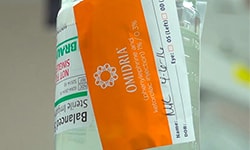Editorially Independent Content
Omidria (phenylephrine and ketorolac injection) 1%/0.3% (OMEROS) is a relatively new product in ophthalmology. The formulation was released in April of 2015 and is the only FDA-approved intracameral medication that contains ketorolac and phenylephrine to maintain pupil dilation during eye surgery and decrease pain in the immediate postoperative period.
How it Works
The compound comes in a 4ml bottle that is diluted in the 500cc bottle of balanced salt solution (BSS). Each component of Omidria works differently to maintain pupil dilation during surgery. Phenylephrine, an α1-adrenergic receptor agonist, induces mydriasis by constricting the radial muscle of the iris, resulting in pupil dilation. In the eye, prostaglandins affect the smooth muscle cells in the iris and cause it to constrict. Ketorolac maintains pupil dilation by inhibiting the synthesis of prostaglandins resulting from normal surgical stress and direct mechanical stimulation of the iris. Additionally, ketorolac is a nonsteroidal anti-inflammatory drug that inhibits both cyclooxygenase enzymes (COX-1 and COX-2), resulting in a decrease in tissue concentrations of prostaglandins to reduce pain due to surgical trauma.
The Importance of Being Open
With increased expectations from patients in regard to outcomes and comfort both during and after surgery, we want the pupil to be as dilated as possible to help the surgeon get through the case as safely and quickly as possible. Studies show that when the pupil starts to come down during surgery, especially unexpectedly, there is a higher risk of complications.123 Patients may report that they have never taken Flomax (tamsulosin) or don't remember that they have taken a similar medication, so it is difficult to predict when miosis will occur. Omidria provides more control during surgery by maintaining pupil dilation and curtailing postoperative pain, which can make patients’ experiences a more positive one.
Omidria is the only FDA-approved product of its kind. Compounded products are available, but accrediting agencies do not look as favorably on compounded products. Omidria can be a wonderful addition to eye surgery for all surgeons.
1. Chang DF, Braga-Mele R, Mamalis N, Committee. eaftACC. ASCRS white paper: Intraoperative floppy iris syndrome – a clinical review. J Cataract Refract Surg. 2008;34:2153–2162.
2. Chatziralli IP, Sergentanis TN. Risk factors for intraoperative floppy iris syndrome: a meta-analysis. Ophthalmology.2011;118:730–735.
3.Chang DF, Campbell JR, Colin J, et al. Prospective masked comparison of intraoperative floppy iris syndrome severity with tamsulosin versus alfuzosin. Ophthalmology. 2014;121:829–834.




